Nikon Nikkor AF-S DX 18-300 mm f/3.5-5.6G ED VR
3. Build quality and image stabilization
In the photos below you see both Nikkors 18-300 mm VR and the Sigma 18-300 mm OS set at 18 and 300 mm focal lengths.
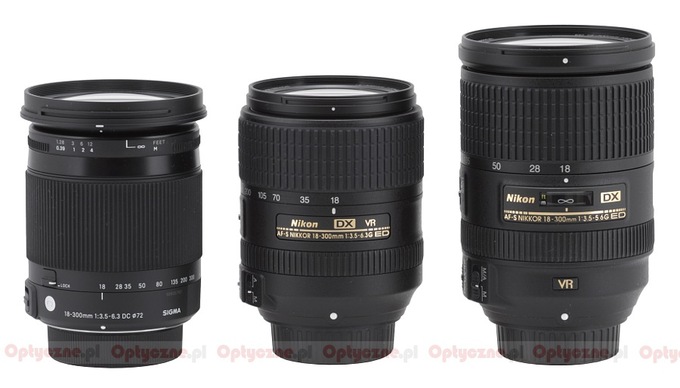 |
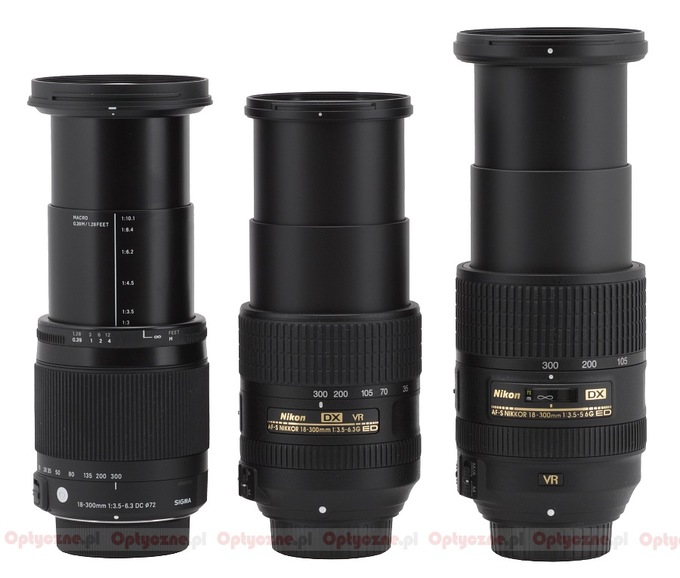 |
Please Support UsIf you enjoy our reviews and articles, and you want us to continue our work please, support our website by donating through PayPal. The funds are going to be used for paying our editorial team, renting servers, and equipping our testing studio; only that way we will be able to continue providing you interesting content for free. |
- - - - - - - - - - - - - - - - - - - - - - - - - - - - - - - - - - - - - - - - - - - - - - - -
The tested lens starts with a metal bayonet mount surrounding the contacts and a rear element which is almost 22 mm in diameter. That element is situated on the same level as the mount when the focal length is set at 18 mm. After passing to 300 mm the element hides inside the barrel almost 5 cm deep. The interior of the tube is nicely matted and darkened, without any light, shiny electronics or mechanical parts.
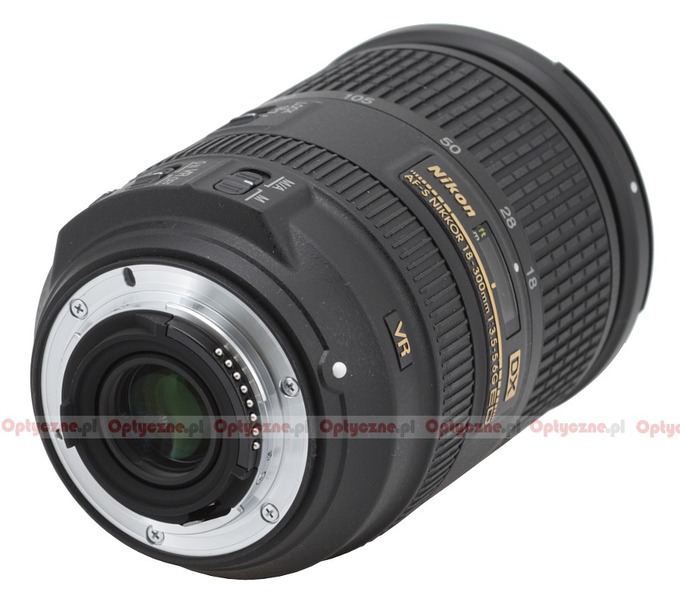 |
The proper body of the lens is covered by plastics; it starts with a part featuring a white dot which makes the alignment with a camera easier. Above it there is a “VR” (short for Vibration Reduction) mark meaning the optical image stabilization was implemented. On the left you find three switches: the first one allows you to choose the focusing mode (M/A-M), the second one controls the optical stabilization (VR ON/OFF) and the third one is responsible for the stabilization modes (NORMAL/ACTIVE).
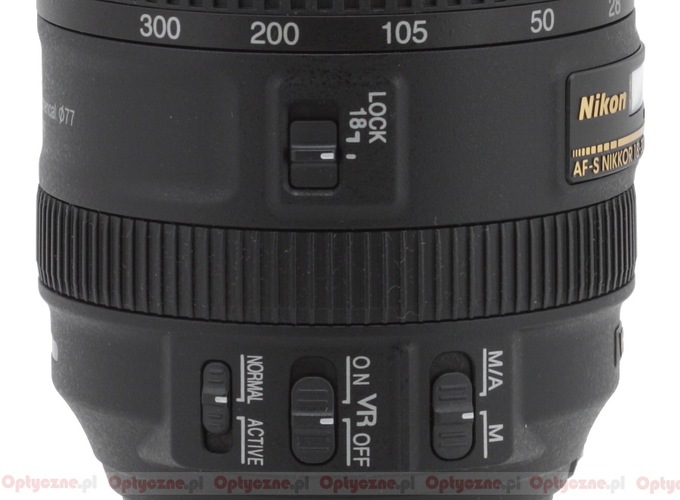 |
The next part is a manual focus ring. It is 13 mm wide and covered by comfortable rubber ribs. It moves smoothly and is well-damped; unfortunately, it also has noticeable initial play/slack, so typical for the Nikkors. A delicate turning of the ring even by one rib doesn’t move the distance scale. Still the ring should be praised for two things. Firstly, its working range amounts to as much as 220 degrees, a rare thing in this class of equipment. Secondly the ring works also in the AF mode which means you can manually fine-tune the focus after it was set automatically without the necessity of changing the focus working mode (M/A-M).
Further on you see a plate with the name and the parameters of the lens inside which there is a window with a distance scale expressed in feet and meters. On the left side of the plate you can find a switch locking the lens at 18 mm; on the other side of the scale there is the name and basic properties of the lens and information that it was produced in Thailand.
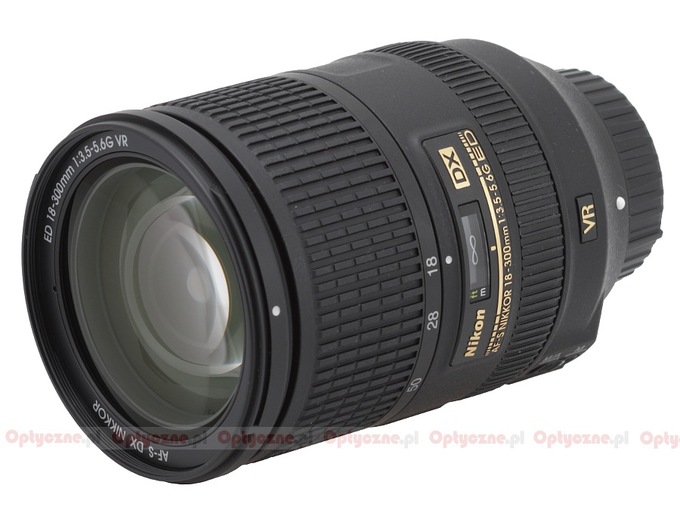 |
The next part is a big, 4 cm wide, zoom ring. Most of it is occupied by comfortable, rubber ribbing and underneath you see focal length markings at 18, 28, 50, 105, 200 andá300ámm. The ring doesn’t move evenly, the 50-200 mm range having the most of resistance; its movements make the front element system extend on a telescopic tube which first part is made of metal and the second of plastics. During that operation the size of the lens increases by 87 mm. The tube doesn’t have any zoom creep tendency.
The front element of the lens is 62 mm in diameter; around it you can find the name and the parameters of the lens along with a non-rotating filter thread, 77 mm in diameter, and a hood mount.
It’s worth checking how the maximum relative aperture of the tested lens changes with the change of the focal length – it is presented in a chart below. The surprise is evident at once: in this category the fastest Nikkor 18-300 mm f/3.5-5.6 beats its direct rivals only at the longest focal lengths. In the middle of the range the Sigma and the cheapest Nikkor 18-300 mm f/3.5-6.3 are actually faster!
|
|
|
||||||||||
|
|
|
|
|
|
|
|
|
|
|
|
|
| Nikkor 18–300 f/3.5–5.6 |
|
|
|
|
|
|
|
|
|
|
|
| Nikkor 18–300 f/3.5–6.3 |
|
|
|
|
|
|
|
|
|
|
|
| Sigma 18–300 f/3.5–6.3 |
|
|
|
|
|
|
|
|
|
|
|
When it comes to the optical construction you deal here with 19 elements positioned in 14 groups (including three ED glass and three aspherical elements). The tested Nikkor is definitely optically more complex that the newer and slower Nikkor 18–300ámmáVR f/3.5–6.3 which has overall 16 elements. The rival Sigma 18–300ámmáOS has just 17 elements but more low-dispersion ones.
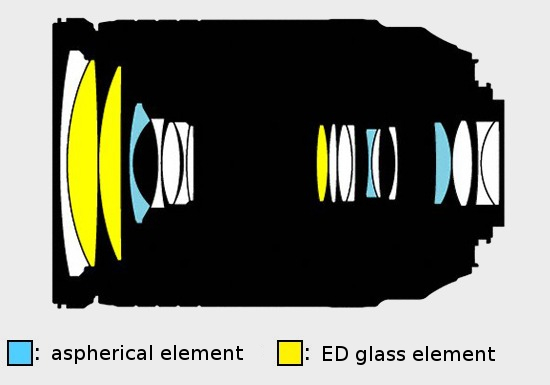
Inside the tested lens you also find a round aperture with nine blades which closes down maximally to a value from f/22 to f/32, depending on the focal length you use.
Buyers get a snap-on front element cap (LC-77), a rear element cap (LF-4), a petal –type bayonet lens hood (HB-58) and a soft pouch (CL-1120) in the box.
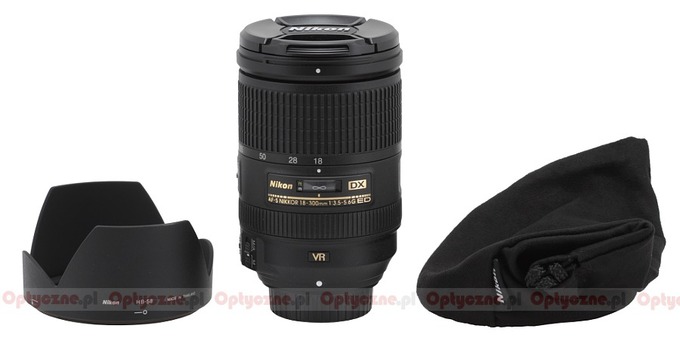 |
Optical stabilization
The tested lens is equipped with an optical image stabilization system which efficiency is supposed to amount to 3.5 EV (according to the declarations of the producer). Of course we didn’t fail to check that claim. In order to do so we took several dozen photos at 300 mm focal length in a range from 1/320 to 1/5 of a second with the stabilization switched off and on. Then we determined a percentage of blurred photos for every exposure time and presented it as the exposure time function, expressed in EV (and 0 EV is an equivalent of 1/250 of a second). The results are shown in the graph below.

You can notice that, within the margin of terror, the claims of the producer are in accordance with the measurements. The maximum distance between both curves reaches 3.3 EV so very close to 3.5 EV, declared by Nikon. It is hardly a sensational result because the best lenses can be as efficient as 4 EV and more but definitely it is not a reason to complain either, especially that the rival Tamron 16–300ámmáVC had precisely the same result in this category.






